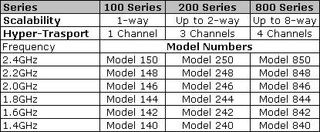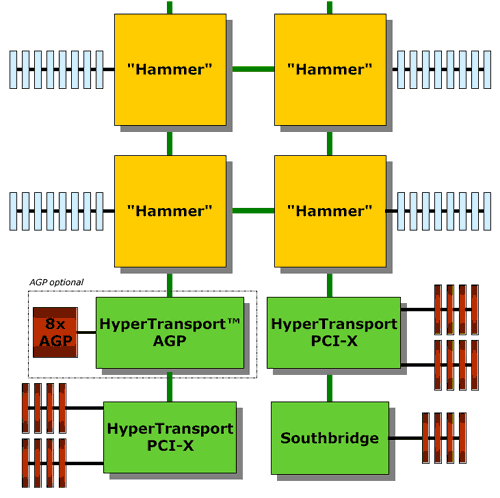AMD's Opteron 250 vs. Intel's Xeon 3.6 GHz in a Workstation Duel of the Elite
One, Two, Four... Or How About Eight CPUs?

Overview of model numbers and HT channels
The way the Opteron processors are named is only confusing at first glance. If you look closely you will detect an easily comprehensible system, which first and foremost determines the number of HyperTransport channels. We will deliberately dispense with the "HT" abbreviation here, to prevent any confusion with Intel's HyperThreading.
Every HyperTransport channel is designed to be bi-directional and works with 16 bits. A 200 MHz speed (quad-pumped, the clock speed adds up to 800 MHz) yields a bandwidth of 3.2 GB/s - or 1.6 GB/s per direction. The channels are used to respond to either an I/O device (e.g. PCI-X bridge, AGP) or another Opteron processor. Each Opteron basically has a dual-channel memory controller.
| Header Cell - Column 0 | Opteron 100 Series | Opteron 200 Series | Opteron 800 Series |
|---|---|---|---|
| HyperTransport channels | 2x 200 MHz quad-pumped | 3x 200 MHz quad-pumped | 4x 200 MHz quad-pumped |
| Total bandwidth I/O | 6.4 GB/s | 9.6 GB/s | 12.8 GB/s |
| Applications | Single-processor | Single-processorDual-processor | Single-processorDual-processorMulti-Processor( up to 8) |

A system with two Opteron processors.

A 4-way system.

This is what an eight- or multi-processor system looks like. However, this is intended exclusively for the server world.
Stay on the Cutting Edge
Join the experts who read Tom's Hardware for the inside track on enthusiast PC tech news — and have for over 25 years. We'll send breaking news and in-depth reviews of CPUs, GPUs, AI, maker hardware and more straight to your inbox.
Current page: One, Two, Four... Or How About Eight CPUs?
Prev Page AMD Opteron Processor Next Page One, Two, Four... Or How About Eight CPUs? Continued-
bgd73 hey thanks for this. There is errors in the test, especially in memory speed of xeons, in fact, it is ridiculous. I am going for older 7525 chipset in CEB motherboard...these machines are just getting started. I be sure to go for HT. thanks.Reply
Most Popular


